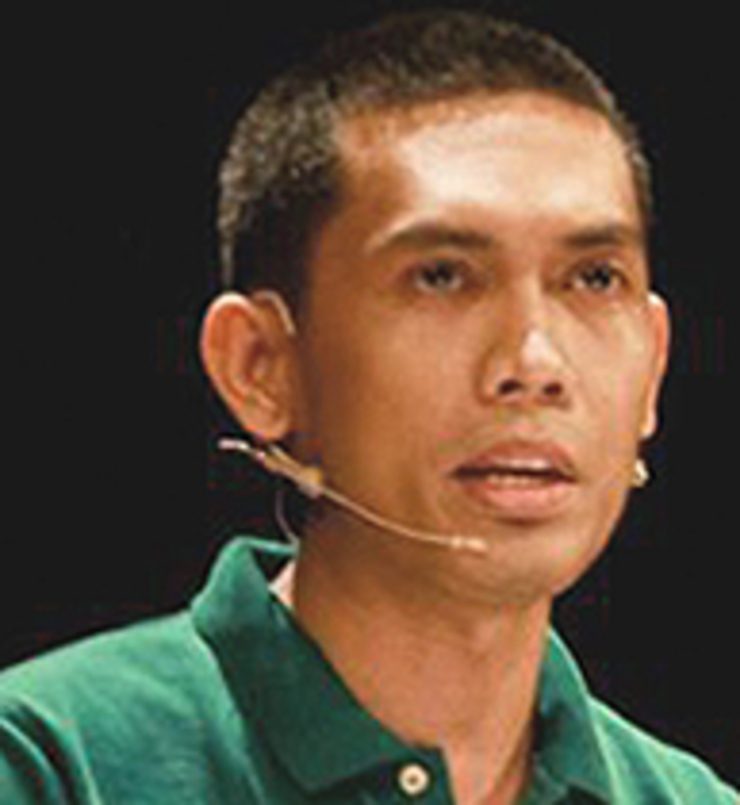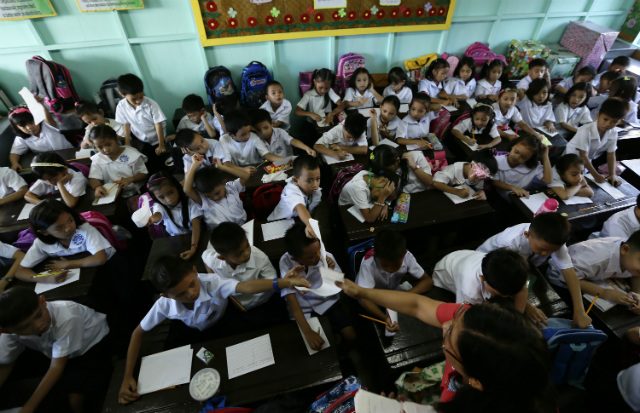SUMMARY
This is AI generated summarization, which may have errors. For context, always refer to the full article.

Philippine government officials repeat two tired catchphrases to justify the imposition of K to 12: “global competitiveness” and labor export.
It must be reiterated that in the United Nations’ Human Development Index (HDI) Report 2014, there are actually 70 countries poorer than our republic. Only two of those 70 countries – Angola and Djibouti – are non-K to 12 countries.
In his last State of the Nation Address (2015), President Benigno Aquino III claimed, “The credentials of our countrymen working overseas are already being questioned; there are also some who have been demoted because our diplomas are supposedly not proof of sufficient knowledge.”
Filipinos are in demand everywhere
Reality is against the government’s claim.
For example, even without K to 12, the United Kingdom’s National Health Service (NHS) actively recruits Filipino nurses, with UK agents directly going to the Philippines to seek nursing graduates that will fill in around 24,000 vacancies as of 2016. Government-approved London nursing vacancies accept any nursing graduate with just a year of work experience. No mention of a senior high school diploma!
A Singaporean newspaper reports (2013) that “Filipino professionals head to Singapore as tourists to seek jobs,” and do land good-paying jobs – a monthly salary of $2,000 way above the average salary of a college graduate in the Philippines ($400) – even without K to 12 diplomas.
A cursory check of the Philippine Overseas Employment Administration (POEA) website yields thousands of still active job vacancies (posted from 2013 to 2016) for Filipino engineers, teachers/professors, chemists, social workers, architects, agriculturists, dentists, foresters, geologists, guidance counselors, interior designers, librarians, master plumbers, medical technologists, doctors, midwives, nutritionists, optometrists, pharmacists, therapists, psychologists, radiologists, and veterinarians – professions regulated by the Philippines’ Professional Regulatory Commission.
Hence, even without K to 12, Filipino workers/professionals are in demand everywhere. The number of overseas Filipino workers (OFWs) deployed by the POEA soared to 1,832,668 in 2014 (roughly 5,000 deployed daily) from 1,470,826 in 2010 (roughly 4,000 deployed daily).
Even prior to the implementation of the K to 12 scheme, the Philippines was Southeast Asia’s biggest remittance receiver – second only to China in the Asia-Pacific region. From 1962-2012, the Philippines also ranked worst in Southeast Asia with regard to net migration – more people leaving than entering the country. Every country in these regions is K to 12-compliant.
Considering that K to 12 and labor export complement each other, the country’s economy will be further reliant on remittances from OFWs once this educational scheme is fully implemented.
Will K to 12 resolve unemployment?

Historically, except for a few years between 1991 and 2013, the Philippines has ranked first in Southeast Asia in terms of unemployment. However, some K to 12-compliant countries like Vietnam, Cambodia, Timor Leste, and Laos have more vulnerable workers (“unpaid family workers and own-account workers”) than the Philippines.
As K to 12 is meant to further encourage Filipinos to go abroad, we ask: is labor export a good policy? The article “Pambansang Salbabida at Kadena ng Dependensiya: Isang Kritikal na Pagsusuri sa Labor Export Policy (LEP) ng Pilipinas”/ National Lifesaver and Chains of Dependence: A Critical Review of the Philippine Labor Export Policy (LEP) tackles this.
Why exporting more OFWs is bad
As per World Bank data, the Philippine manufacturing sector contributed only 21% to the GDP from 2010 to 2012 and in 2014, and a percentage point lower in 2013, compared with an average of 25.2% from 1980 to 1984, a few years after the Labor Export Policy was adopted.
According to World Bank data, remittances’ contribution to the GDP averaged 10.14% from 2010 to 2014 – a certain leap from an average of 2.52% from 1980 to 1984. During much of the same period (1999-2014), the Philippines’ balance of payments was consistently negative (more imports than exports).
In other words, as Prod Laquian, professor emeritus of human settlements planning at the University of British Columbia, eloquently puts it: “The most serious negative effect of labour export policies has been the neglect of domestic production and poor investments in infrastructure, agriculture, mining, export promotion, and social development because of the easy availability of funds from remittances…. For the government, the easy money from foreign remittances is a major cause of its inability to pursue sound economic development programs.”
Comparable with the Philippine context is Nepal’s remittance-driven economy, in contrast with the economies of a number of industrialized or semi-industrialized countries in Asia (South Korea, Malaysia, China). Like the Philippines, Nepal’s manufacturing sector is also weak, while that of South Korea, Malaysia, and China is robust.
Industrialization: Alternative to labor export
Resource-rich countries like the Philippines can’t develop or achieve high levels of progress if they don’t industrialize as by Ha-Joon Chang’s “Bad Samaritans: The Myth of Free Trade and the Secret History of Capitalism” and Alejandro Lichauco’s “Nationalist Economics: History, Theory, and Practice.” The Philippine government’s decision to add two more years of high school to further expand Labor Export Policy – rather than align the education system with the goal to industrialize the country and strive for economic self-reliance as much as possible – is bad.
Labor export = brain drain. A UK research concluded that brain drain holds back economic growth in the country. The Philippines’ brain drain problem is more acute in the Science and Technology sector, leading a top Department of Science and Technology official to say “We need more of our S&T (Science and Technology) R&D (Research and Development) professionals to be here in our country to provide the lifeline of our research and development agenda. Our country currently stands at 165 R&D personnel per million Filipinos, which is way below the UNESCO recommendation of 380 needed for economic development.”
Even supporters of the K to 12 program – such as Masayoshi Okabe of the Japan-based Institute of Developing Economies – admit that enhancement of secondary education “alone could very well further the brain drain (or worse still, lead to further “brain waste [Spring 2009: 188-190)].” Hence, “along with improving education, the government needs to encourage industrial development and growth of domestic industries that can provide employment for higher educated school graduates.”
Jose Maria Sison notes: “A K-12 program, properly oriented, planned, and managed, could lead to genuine reforms that will truly benefit the Filipino people and youth in the realm of education. A truly patriotic, mass-oriented, and scientific educational system will be able to train millions of youth, help empower the people and build their nation through heightened social consciousness, scientific knowledge and technical skills.”
Unless K to 12’s framework is reoriented toward the objective of developing the country, rather than expanding labor export, it is clear that K to 12 will just be another failure.
Practical alternative to K to 12
In the only quantitative research on the issue of length of the school cycle and quality of education, professors Abraham Felipe and Carolina Porio point out a practical alternative: “There is no clear empirical basis in TIMSS to justify a proposal for the Philippines to lengthen its education cycle…. There is no basis to expect that lengthening the educational cycle calendar-wise will improve the quality of education…. The value of the 12-year cycle is ultimately a matter of weighing the large and certain costs against the uncertain gains in lengthening the education cycle…. The government could help those interested in foreign studies and work placement by supporting an appropriate system of assessment, rather than tinker with the whole cycle length. This solution addresses the alleged problem in a more focused way and does not indiscriminately impose on every Filipino the costs of meeting the needs of a few.”
With regard to foreign studies, even without K to 12, Filipinos are able to gain acceptance in prestigious scholarships abroad such as the European Union’s Erasmus Mundus Programme. According to the European Union, from 2004 to 2014, “more than 200 students and lecturers [from the Philippines] benefitted from the programme.” Yearly, dozens of Filipinos also benefit from the United States-based Fulbright program.
Immediate socio-economic reforms needed
The additional budget that would be allotted to the K to 12 scheme will be better spent on improving the current 11-year Basic Education cycle first. Measures to improve the old basic education cycle should include:
- Salary hikes for teachers and staff (teachers’ salaries in the Philippines are so low that teachers resort to exploitative and, at times, murderous loan sharks to make both ends meet)
- Modernization of all facilities (the K to 12 curriculum – in many subjects – talks about technology, blogs, internet, etc, but a visit to the typical public will immediately make you realize K to 12 fails on its own standards)
- Wiping out of all backlogs in personnel, facilities, and instructional materials (go visit the nearest public school, ask a public school teacher, check the Facebook page of teachers’ organizations like the Alliance of Concerned Teachers and ACT Teachers’ Partylist)
- Full-blast teacher training (considering that even a number of our teachers lack sufficient English, Math, and Science skills)
Debates on whether to add two more years in high school should start once the 11-year Basic Education cycle from Kindergarten to Grade 10 is perfected.
Additional investments in the tertiary level and R&D are also important. The Philippines lags behind many countries when it comes to R&D expenditures, hence the country is also weak in innovation and modernization of technologies in education and other fields.
Additional budget for the tertiary level is important in ensuring that more students will finish their schooling. It has been proven that the “rate of return” of investment in studying in college and beyond is huge. Moreover, as a World Bank study points out, “tertiary education is to a large extent a prerequisite for highly-paid occupations.”
We reiterate that job opportunities within the country must be broadened through implementing a comprehensive economic plan that focuses on self-reliance or self-dependence. This can be done through national industrialization, agrarian reform, and modernization of agriculture – policies which have been tackled and discussed in detail by many Filipino thinkers and social movements throughout the country’s recent history (Recto, c.1959; Hernandez, 1982; Lichauco, 1986 and 2005; Constantino, 1995; Salgado, 1997; Sison, 1998; Kilusang Magbubukid ng Pilipinas/KMP, 2009; Bagong Alyansang Makabayan/BAYAN, 2011).
Agrarian reform will strengthen the financial capability of the country’s peasant majority, and consequently expand the domestic market while supplying it with basic raw materials too. Thus, agrarian reform will complement any industrialization endeavor.
The role of the education system in transforming the country into a developed archipelago should be obvious by now: innovations in agriculture and industry – expectedly accelerated by schools, universities, and research centers aligned with the country’s development objectives – will enable the country to swiftly achieve national and sustainable development, based on the common good rather than corporate profit.
The requisite perfection of K to 10, and the revival of vital subjects abolished by K to 12 – such as Philippine History in high school, and Filipino, Literature and Philippine Government and Constitution in college – should at least be pursued, if a national development-oriented education system will be achieved. These programs are anchored on the Philippines’ capability to utilize its resources for its own citizens’ progress, and not merely as exports to other countries. – Rappler.com
A Brunei-born Filipino citizen, David Michael San Juan serves as associate professor at De La Salle University-Manila.
Add a comment
How does this make you feel?
There are no comments yet. Add your comment to start the conversation.